About Romania
Romania is the country of eternal beauty, showing the whole world the last surviving territories of ancient Europe, as they once were, in terms of natural landscapes and wildlife.
While time passed very slowly in this land of fairytale, the harsh history shaped its people and traditions, preparing them for their rebirth. Nowadays, the country shines through its material and spiritual values with a unique style, unified by its great diversity. Romania has a reputation for legends and is also known for the astonishing myriad of monasteries and exterior frescoes, from which eight of them had received particular recognition, being taken under the aegis of UNESCO as Heritage Sites due to uniqueness and universal artistic value.
The Carpathian mountain range spans over 200 000 km2, in a great arch which crosses both, Central and Eastern Europe. Cradled beneath its jagged peaks and amongst trackless miles of forest, you can find one of the few surviving medieval landscapes in Europe. Formed at the same time with the Alps, a great part of these imposing mountains, are stretching across the area of modern day Romania, known as Transylvania – a place of myth and legend, birthplace of Dracula, where the distant howls of the wolfs still chills the night air.
Bucharest, the capital city is on the other hand, as modern as it gets, a bustling metropolis that never sleeps. Known in the past, as being “The little Paris”, due to its wide boulevards and Belle Époque buildings, today the city is home to over 2 million people and to an impressing number of monuments, museums and touristic attractions.
Europe’s hidden gem, Romania, is often overlooked by tourists, but for the ones who take the time to discover it, it is a beautifully blended mix of medieval treasures, imposing castles, undisturbed forests that host the largest brown bear population in Europe and traditional villages, which offer to its travelers a glimpse into the undisturbed, traditional way of life.
Be the one night owner of Dracula’s Castle and have dinner with the Count himself.
Walk between castles and palaces and conquer medieval fortresses.
Experience the UFO-like salt mine, in Turda.
Discover the ever active Mud Volcanoes.
Enjoy an exquisite wine tasting in one of our richest wine regions: Transylvania, Dobrogea or Moldavia.
Be part of Bucharest’s spectacular night life.
Shop for one of the most appreciated traditional clothes: the "Iia", which has been an inexhaustible source of inspiration, for the most notable designers and fashion houses, such as: Oscar de la Renta in 2000, Jean Paul Gaultier in 2006, Emilio Pucci in 2011, Tom Ford in 2012, Dolce & Gabbana and Carolina Herrera in 2013.
Visit the second largest administrative building in the World - the Palace of Parliament in Bucharest.
Drive along the most scenic road in the world – the Transfagarasan.
Ski in Romania’s no. 1 ski resort: Poiana Brasov.
Join one of our horse trail rides through the magic landscape of Transylvania.
Make a noteworthy trip in one of the most charming and filled with personality trains, belonging to the Romanian “fleet”: the 1912 steam train called Mocanita, or the train that once belonged to the Royal Family of Romania.
Enjoy a cruise on Europe’s Amazon - the Danube River and unravel Danube Delta’s vast mystery.
Be part of one of the countless trekking adventures taking place in the rugged and spectacular Carpathian Mountains.
Immerse yourself in the authentic rural atmosphere of Romanian villages.
Try your skills by participating in one or more captivating workshops where you can learn our traditions. How about trying one of the most appreciated handicrafts in Romania? You will have the chance to learn from the masters, while the amount of ways one can paint and adorn an egg, will leave you in awe. You can also try working the wool with the spindle, painting icons on glass or make pottery on the wheel, amongst many other.
Romania has a temperate climate with four distinct seasons, which makes it a suitable destination for tourism throughout the year. Local differences in temperature are caused by altitude, oceanic influences coming from the west, Mediterranean influences coming from the southwest and continental influences from the east. During winter, the average temperature drops below - 3° C, while during summer, it varies between + 22 and + 24° C. The annual average rainfall is 637 mm, with values significantly higher in the mountain regions (1000 – 1400 mm, annually) and progressively lower towards the east (below 500 mm, annually). Romania is a destination that you can enjoy year-round, the perfect period depending only on the individual taste for specific activities.

Getting around:
Most cities in Romania have a good public transport system. Tickets are usually cheap, costing between 1 to 3 lei (0,25 to 0,8 USD) per ride.
Bucharest is the only city in Romania that has an underground metro. You can get a card valid for two rides for 5 lei (1,2 USD), 10 rides for 10 lei (2,4 USD) or a 1 daily pass for 8 lei (1,9 USD).
Taxis are very easy to find on the street. However, it is recommended to order taxis using a mobile application Clever Taxi or Star Taxi. A good alternative to taxis are ridesharing services like Uber or Taxify.
Opening hours:
Shopping centers are open from Monday to Sunday between 9 am and 10 pm.
Supermarkets are usually open between 7 am and 9 pm. There are also several non-stop supermarkets, especially in Bucharest.
Most banks are open between 9 am and 5 pm from Monday to Friday. The banks inside large commercial centers and mall have longer opening hours and are usually open on Saturday as well.
Museums are open Tuesday to Sunday, usually between 10 am and 5 pm.
Bars and clubs are open between 6 pm and 3 am.
Tipping:
Tipping is common in Romania, especially to service workers such as guides, taxi drivers or hotel staff. Usually a tip of around 10% is expected, but you can tip more if the service is excellent.
Restaurants: 5% to 10%. Usually the service charge is not included in the bill.
Hotel maids: 5 lei (1.5 USD) per day.
Tour guide: tour guides are usually tipped 10 – 20 lei per day.
Dracula - Fact vs. Fiction
Enjoy a guided tour of Bucharest, focused mostly on the historical figure of Vlad the impaler aka Dracula. You will first see the Old Princely Court where Vlad the Impaler had his headquarters. Then, you will drive to Snagov Monastery, where his tomb allegedly lies. On your return you will visit the Village Museum and have a traditional lunch in a local restaurant. A licensed guide will be with you throughout your tour.
Duration: Approx. 7 hours.
Tales of Dracula’s Castle Private Tour
Depart from your hotel and drive north out of Bucharest to the Romanian Carpathians, through the scenic Prahova Valley. Reach Sinaia Resort for a nice refreshment stop at the Palace Hotel, followed by a maximum of 30 minutes of free time in the park of the 1913 Sinaia Casino. Proceed then over the Carpathians to the small village of Bran, the location of the castle that apparently inspired Bram Stoker, author of the novel “Dracula”.
Visit the ominous Bran Castle and be a part of the Dracula legend. See this true fortress, so well located and defended, that no one managed to conquer it in its 630 years of existence. You will then have free time for shopping at the foot of the castle, in a nice local market, with all sorts of souvenirs and traditional products. Lunch will be served in the village of Bran, at one of the best restaurants in the area. You’ll be transferred then to the city of Brasov, one of the best preserved Saxon cities in Transylvania.
You’ll be given around 1 hour to see the central square and take photographs – the History Museum, the Black Church, the Council Square & the pedestrian street – free-time. Return then to Bucharest, with one comfort stop on the way.
Duration: 12 and-a-half hours.
City of Contrasts
Guided tour of Bucharest that includes a visit to the People's Palace, a traditional lunch and three photo stops, at the most representative sites. The Patriarchy Church is also on your program. A licensed guide will be with you throughout your tour sharing interesting information.
Duration: Approx. 8 hours.
Best of Bucharest (Full Day)
Depart from your hotel and begin your extended panoramic tour of Bucharest. Once called the “Paris of the Balkans”, Bucharest is a fascinating city with countless contrasts which can be observed at every step. Its compelling history is reflected in the beautiful architecture of the oldest part of the city, but also in the communist-built apartment buildings.
Its wide boulevards and large squares, its monuments and museums, its parks and shopping centers are definitely worth a look. Founded apparently in the 14th century by a shepherd named Bucur, Bucharest is also connected to Prince Vlad the impaler, as it got its 1st official mention in history, under this name, in a 1459 document from his court. He was the 1st one to realize the huge strategic and economic potential of Bucharest and set the foundation for the more prosperous centuries that were to follow.
First you will visit People’s Palace, the second largest administrative building in the world, after the Pentagon (USA) and the greatest expression of Ceausescu’s megalomania. After this unique experience you will see the Romanian Patriarchy from the bus and have a traditional lunch in one of Bucharest’s most appreciated venues. You will then proceed to visit one of the largest open-air museums in Europe, the Village Museum. You’ll have the chance to see original rural households from all areas in Romania, which were actually brought to here in pieces in the 1930’s and reassembled on site. You will gain valuable insights into folk culture, architecture and life. You will also have the opportunity to purchase original handcrafted souvenirs and information booklets from the museum’s shop. Your tour also includes photo-stops in the city’s most interesting places. In addition (30-40 minutes), you will enjoy a short guided walk of the historical center.
Duration: Approx. 7 Hours
4x4 Tour and Adrenaline Experience in Transylvania
This guided 4x4 adventure tour is ideal for people who want to escape from the city, experience untouched nature and love adrenaline experiences like ATV, horse riding, bungee jumping, zip-lining, rappelling, pendulum. You will be travelling away from crowded places and roads, reaching some of the most beautiful places in the mountains, rivers, traditional villages- most of them are accessible only by 4x4 vehicle.
Experience 1 day 4x4 tour with off road tracks in the Carpathian Mountains combined with special highlights and adrenaline outdoor activities. Enjoy nature and have fun!
After being picked up from your hotel in Bucharest, your 4x4 journey begins by crossing Prahova Valley to special location and get ready for adrenaline experiences. Take flight on the highest zip line in Romania or enjoy rappelling adventure. Optional you can enjoy ATV/ horse riding, bungee jumping, pendulum. No experience required for all this outdoor activities! All equipment is provided.
You will enjoy the off road trip to the hilltop villages of Magura and Pestera, with some of the best breathtaking views in Romania. These are traditional and picturesque mountains villages which reveal the pastoral way of life of the Transylvanian shepherds. Along the way we will across gorgeous landscapes with magnificent views over the Piatra Craiului and Bucegi Mountains.
Then, you will get to see a very special place Amfiteatru Transilvania and enjoy fantastic views, remote traditions, animal farm, traditional local food and drinks, living water spring and souvenirs. If time permitting you can visit also Fundata, the highest village from Romania and return off-road trough Dambovita Canyon.
In the evening, we leave beautiful mountains landscapes behind and return to Bucharest.
Bucharest Jewish tour
Bucharest had in the past one of the most prosperous Jewish Community. In the Inter-War period, almost 11% of Bucharest's population was represented by Jews. The events of the Second World War, but also the migration to Israel transformed the community. Today, in Bucharest there are almost 3000 Jews. The community is very well organized, even if the Jewish neighborhood was destroyed in the 80s, during Ceausescu’s regime.
During this tour you will discover the most important Jewish monuments that survived, you will have the chance to see The Great Polish Synagogue, built in the second half of 19th century by the Polish- Jewish community, The Holy Union Temple that hosts the History Museum of the Romanian Jews, The Jewish State Theater, one of the first professional Jewish theaters in the world and the only Jewish grocery. You will also discover the Choral Temple that was just renovated and re-opened for the public this year. For the architecture enthusiasts, you will discover modern buildings built between the wars by famous Romanian-Jewish architects such as Marcel Iancu or Jean Monda.
Duration: 3 Hours
Complete Bucharest Half Day Bike Tour
We start the tour in one of the most loved parks of Bucharest – Herastrau. It is by far the best place to be in the sometimes hot afternoons of Bucharest. Here we’ll just take advantage of the shade and the breeze as we’re on bikes.
From the park we have a short look at the Village Museum and head to the House of Free Press formerly known as The House of the Spark (one of the main Communist Journals). After analyzing how Romanian Society changed through the power of media to create and impose models we’ll bike south to the very “Parisian” Arch of Triumph. A relaxing ride on the green Kiseleff “Embassy Road” will lead us in the vicinity of Eternal snoring source – the Palace of the Government in Victory Square. By far more interesting are the 2 nearby museums which we’ll discuss – The Peasant Museum and the Geology Museum.
Crossing Victory Square we’ll head towards Romana Square. and right after we grab some local pies we stop in front of our pride – The Atheneum where the Philharmonic performs. It is an extremely loved, which could seem quite odd given the lack of popularity of classical music today. After we get out of this dilemma we plunge in an deeper one – 1989 Revolution against the Communist Regime which concluded (perhaps a bit cynical) in a very costly change of a Political Party name – more than 1200 people lost their lives in mainly 2 weeks.
After we pass the oldest public garden of the city (Cismigiu Park) we stop for a chat in the “shadow” of a White Elephant – The Palace of the Parliament formerly House of the People. To feel its size we’ll bike in front of it to understand also what it meant for the people we are going to have a look behind the facades and discover a more than 300 years old Monastery – perfect setting for a discussion about church – state relation in the past times. Close to the end we’ll have the biggest “challenge” of the day – go up the hill (in Bucharest every 15 mtrs gain of altitude is considered a hill) on the top of which we’ll find the currently Heroes Monument in Carol Park.
Downhill to the finish and after about 4h and 20km of biking, talking and especially smiling you can say you took the time to fall in love with Bucharest.
Duration: 4 Hours.
Bucharest Walking Guided Tour
A 3-hour guided walking tour of the beautiful capital of Romania, Bucharest. Known as "the little Paris of the Balkans" before WWII, famous for its beautiful palaces, wide boulevards, large parks, and many pristine churches, the capital of Romania underwent many changes during the Communist period which ultimately altered its architectural landscape and led to sometimes chaotic urban planning.
Today, Bucharest is a bustling city of many contrasts, that managed to somehow harmonize all these eclectic influences into a unique and unforgettable charm. Witness firsthand this amazing mix of influences from the megalomaniac People's Palace to the classy Belle Époque palaces of former aristocrats, to the featureless Communist structures.
Walk through the city and discover its architectural highlights (Constitution Square, People's Palace, the old historical center of Bucharest, featuring Manuc's Inn, Stavropoleos Church, the Princely Court, and St. Anton Church - the oldest place of worship in Bucharest, the Romanian Savings Bank, the National History Museum, the Romanian Atheneum, Revolution Square, the Former Royal Palace, followed by the National Theatre and University Square). Opportunities for lunch are abundant in the Old City as the area has been close to fully refurbished. Coffee and refreshments are also available, and so are typical Romanian souvenirs. If visit the Romanian Metropolitan Church, a 17th century Orthodox church.
Constitution Square, People's Palace, the old historical center of Bucharest, featuring Manuc's Inn, Stavropoleos Church, the Princely Court, and St. Anton Church - the oldest place of worship in Bucharest, the Romanian Savings Bank, the National History Museum, the Romanian Atheneum, Revolution Square, the Former Royal Palace, followed by the National Theatre, the Intercontinental, and University Square.
Duration: 3 Hours.
Communism Tour of Bucharest
Bucharest today is a nice city to live in, yet until the late 1980's, Romania was a communist state and Bucharest was a troubled place. Anything related to the west was forbidden to the extent that even talking to a westerner on the street could mean a trip to a Police station for an interview with a Securitate (secret police) officer. That era left its marks on Bucharest, a city once known as 'Little Paris'.
Your tour starts at Revolution Square, the place where the fight for liberation started. Then, you will continue your trip towards the Archives, a building that still bears the bullet marks of its bloody history.
From there you will head to Constitution Square and to the top of the Palace of the Parliament, the second largest building in the world after the Pentagon. Nicolae Ceaușescu, the General Secretary of the Communist Party, who's regime it was built under, called it 'the People's Palace'. Next the tour will move towards a neighborhood in the north of Bucharest, where you can see examples of the true socialist architecture, and some of the “bedroom quarters”. You will also get to see one of the famous 'Hunger Circles' - an ex-canteen from the communist era, so called because of the severe food shortages at the time.
On your way, you will stop at the Romanian Television HQ (TVR), the Romanian public television station. Due to the ""energy saving program"", the TVR schedule was severely limited to only about two hours per day during the communist era, between 8pm and 10pm, most of which was dedicated to the cult of personalities of Nicolae Ceauşescu and his wife Elena. The two hours of programming were half propaganda and half general entertainment.
You'll then go to the Primaverii neighborhood, one of the most expensive neighborhoods in the city and home to many politicians and local celebrities, where you'll see Ceausescu's house. Nicolae Ceausescu actually occupied a whole block of villas, including one for his security guards and one for domestic servants, and so, this place has remained an exclusive district since then.
Your tour ends at Victory Square, where you'll see Victoria Palace, headquarters of the Prime Minister of Romania and his cabinet.
Duration: 3 hours.
Dark Side Tour Bucharest
We’ll explore the depths reached by human beings in hurting one another. Cheap thrills are best left to Hollywood professionals.
We’re interested in giving you a bit of a context, a broader sense of events unfolding through history in Bucharest. Start your adventure in the city center and visit The Memorial of the Victims of Communism and of the Resistance, a reminder of the cruel events that unfolded between 1950-1977. Learn about the Communist tourture methods that were used in the hundreds of deportation camps and prison across the country.
Next, leave the Golden Age behind and travel back in time in the begining of the 20th century to find out all about the sexy times that Bucharest had before the Communist Regime took power. In 1927, around 12.000 prostitutes and escorts were working in Romania. Hear the stories and legends of Mita Biciclista (the biker) and the beautiful gypsy dancer, Zaraza, that stole the hearts of many men.
Inside a former brothel you'll hear the story of ""The Vampire of Bucharest"", who would use a hammer to attack waitresses who were alone and returning from work. He struck after midnight during unusual weather conditions such as snowstorms, driving rain, high winds, freezing cold or fog. It was Romania's most notorious serial killer that terrorized Bucharest between 1970-1971.
After a short stop to rest,if rest is needed , we'll walk even further back in time, during the Dark Ages. We'll stop by the Saint George's Church, one of the oldest churches in Bucharest, where you'll hear all about the bloody feuds between the Muslim world and the Christian rulers of Romania. Beheadings, ambushes, treachery, martyrs and false gods, our Dark Ages have seen them all.
Finish grand inside the Bellu Cemetery (Bucharest's answer to Pere Lachaise), the first modern graveyard in the city and a place filled with love stories, unique architecture and sometimes even mysteries waiting to be resolved. We will only travel by public transport.
Duration: 3 Hours.
Bucharest Sites & Bites
Start off in Revolution Square, which plays an important role in Romanian history. Notably, Ceausescu made his ill-advised rallying speech to a crowd that quickly turned on him back in 1989 which then led to the Romanian revolution. Close by, there are lots of landmarks, such as the former Royal Palace, the Athenaeum concert hall and Athenee Palace which was the place on everyone’s lips back in the day. In such a historical spot, it only seems right to have a traditional treat. We’ll enjoy a covrig - a daily salty snack for most Romanians. The snack was likely brought to Romania by Hapsburg or German merchants back in medieval times.
Next up, Victory Street: named after the 1871 War of Independence. Although it took until 1918 for Romania to be fully united, hence each region has its own distinct character. This stretch is also home to a bunch of other iconic inter-war monuments, including the Kretzulescu Church, Telephone Palace, Military Circle and former National Theatre.
We head in to the old town - this is the heart of medieval Bucharest. Here you can witness the many diverse influences on Romanian food — the Balkan mici (skinless sausages), the Ottoman sarmale (stuffed cabbage leaves), Russian borscht and ciorba (sour soups) and Austro-Hungarian schnitzel. Cast your eyes over the lavishly lush interiors and princely courts, the never-seen-before tranquillity of an orthodox monastery and the great wooden inn of Hanul Lui Manuc.
En route to our final destination, we’ll get a look at People's Palace, the centre of Ceausescu’s megalomaniac attempts to re-shape the city and the second largest building in the world (only pipped to the post by the Pentagon!). Try some culinary specialties at a traditional hanu or inn. During the time of the ancient Romanians (the Dacians) so much wine was drunk by the people that their leader: Burebista completely banned its production. The inventive Dacians began brewing beer right away! Pick either fine Romanian wines and/or locally brewed beer, just like the Dacians would have wanted!
Duration: 4 Hours.
Street Art Workshop
Graffiti, Street-Art, Urban-Art; with nearly 20,000 years of cultural evolution behind it, it’s still art by any other name and nothing seems able to slow its phenomenal popularity. We’ve come a long way from the simple cave-paintings of our ancient past, and the amazing diversity of today’s graffiti has has shown incredible resilience and adaptability.
The once-simple idea of drawing on a nearby public wall has become something truly extraordinary in a world increasingly walled-off and walled-in.
Draw, spray, cut and create original pieces of art on a family-friendly street art workshop. This workshop will give you the opportunity to paint and receive instructions on how to create street art as well as graffiti techniques from local artists. Under the close watch of your workshop leader, you will get to make your very own canvas and stencil to take home as a memento of your time in Bucharest.
Duration: 3 Hours.
Romania's Castle Tour
Start at the unforgettable Peles Castle, with its magical charm and beautiful architecture. Admire the result of many artists, wood-carvers and builders that worked to create this neo-Renaissance masterpiece. Although constructed in 1875, some of its features were well ahead of its time and was in fact the first castle in Europe to use electricity.
Explore its Honorary Hallway, filled with Swiss and German landscapes to remind Romania’s first king, Carol I of his homeland. Let the fascinating artefacts take you back in time, featuring the wonderful armour used by soldiers and horses and then move onto the Oriental Room, bearing intricate weapons of the past.
Our next mysterious stop, is at the world famous Bran Castle known for the legendary backdrop to Bram Stocker’s “Dracula.” Perched on top of a 200 foot tall rock, its breathtaking location will win you over. Gaze up at its imposing towers and turrets, making you feel as though you’re lost in the illustrations of a novel. Once used at a royal residence, this castle is now used as a museum and visited by tourists from all over the world. Marvel at the beautiful art collections and furniture collected by Queen Marie.
Duration: Approx. 11 hours.
Royal Escape
Depart from your hotel and drive north out of Bucharest to Sinaia Resort (~2h drive), a place referred to by many as “the Pearl of the Carpathians”. Founded in the late 17th century, Sinaia is by far the most interesting and architecturally relevant resort in Romania, compared by some to a huge open-air museum. In the late 19th century, Sinaia went through a development boom after the building of the King’s royal residence. Proof of this will be all around you. Here, you will visit the breathtaking Peles Castle, the former residence of the Hohenzollern King Carol I. Recently ranked 6th in the top of “Most Amazing Castles in the World” (http://opentravel.com/blogs/15-amazing-castles-from-around-the-globe), PELES will most likely become one of the highlights of your travel experiences. It will give your insight into the life of the Romanian Royal Family and into the greatest period in Romania’s recent history.
After your inside visit you will enjoy a traditional lunch in a local restaurant, situated within the castle’s premises, in the midst of the astounding forests and peaks of the Carpathians. You will continue then with a short stop at the picturesque Sinaia Monastery and find out some more about the Romanian Royal Family, about religion in Romania and the people's relation with the Church. You return to Bucharest through the scenic Prahova Valley and the beautiful fields of the Romanian south.
Duration: 9 Hours.
Bucharest by Night
Depart from your hotel and begin your panoramic tour of Bucharest, the capital of Romania. See Bucharest after nightfall, with all of its historic buildings and squares beautifully lit. Enjoy four photo-stops in the city’s most important places and a nice walk in the historical area. Once called the “Paris of the Balkans”, Bucharest is a fascinating city with countless contrasts which can be observed at every step. Its compelling history is reflected in the beautiful architecture of the oldest part of the city, but also in the Communist-built apartment buildings. Its wide boulevards and large squares, its monuments and museums, its parks and shopping centers are definitely worth a look.
Duration: Around 2 hours 30 minutes.
Historic Bucharest, Snagov Monastery and Shopping
Begin your day by taking in the panoramic views of Bucharest as you tour downtown and the Princely Court. Imagine yourself in a different time as you remark on the historical architecture. Next, head 40 kilometers out of Bucharest to Snagov, a small commune sporting a delightful lake and a historical relevance in its own right. On a small island in the middle of the lake, you will see a 15th century Byzantine church, Bucar Snagov Monastery, which entombs Dracula.
As Vlad the Impaler is the source and inspiration of this legend which invokes a dark and dreary feel, you'll be enchanted by the actual locale of the tomb. The island is a paradise of luscious gardens, flowers, and trees. Afterwards, you'll switch gears, returning to the city to experience Baneasa Shopping City. Spend some free time to explore what's on offer in this sprawling marketplace and grab a bite to eat, before your return.
The tour of the city of Bucharest and the Bucar Snagov Monastery will appeal to a myriad of tastes and leave you with memories of a remarkable place that mixes legend, natural serenity, past and present.
Duration: 6.5 Hours.
Caldarusani Monastery
Explore a spiritual world from centuries long ag while you tour the Caldarusani Monastery, situated close to Bucharest, Romania. Sitting on a peninsula on the shores of a lake bearing the same name, the location is an idyllic oasis of spirituality. On this four and a half hour tour, you'll enjoy experiencing both the history and scenic beauty of the monastery.
Your day will begin with a drive full of panoramic views as you make your way toward the destination. Approaching the Caldarusani Monastery, you will realize why Matei Basarab, ruler of Wallachia, chose this strategic location in 1637-38. At the time of its founding, the whole area was covered in a dense forest, perfect for ensuring privacy. Prior to construction of the monastery, there was a small wooden structure, with just nine monks serving. The church which replaced that first monastery now possesses an important collection of 18th century icons and religious artifacts, along with a library containing extremely valuable manuscripts written by the monks themselves. Enjoy a visit to the museum that houses the most valuable items, including ten icons painted by the famous Romanian painter, Nicolae Grigorescu. You'll have the chance to interact with the resident monks and gain insight into their daily lives. Before making your way back, you will have a traditional lunch on the premises, cooked and served by the monks themselves.
A visit to Caldarusani Monastery will give you a taste of history and leave you feeling peaceful and serene.
Duration: 4,5 hours.
Absolutely Bucharest Tour
Bucharest is Romania’s vibrant capital city filled with a mishmash of grand historic buildings, brutal Communist apartment blocks and emerging 21st century designs.
Your tour will begin in the political center of the city, Revolution Square. Formerly known as Palace Square it has witnessed many of the most important events in Romanian history. It was from here in 1989 that dictator Ceaucescu made his ill-advised rallying speech to a crowd that quickly turned on him, instigating the Romanian revolution. Surrounding the square are several other notable landmarks, including the former Royal Palace, Atheneum Concert hall and Athenee Palace Hilton, the heart of espionage and intrigue in the years between the wars. Leaving the square you will then head south along 'Victory Street' named after the spectacular victory of the new Romanian nation in the 1871 War of Independence, and one of the two main thoroughfares of the city. Here lies many spectacular landmarks of the inter-war period, including the 'Telephone Palace', Military Circle and former National Theatre, as well as the beautiful church of Kretulescu, one of the most famous in Bucharest.
After this you will head into an older part of Bucharest, exploring it's numerous streets, paths and passageways of The Old Town. This is the heart of medieval Bucharest, the literal crossroads between East and West, where Ottoman Pashas rubbed shoulders with Transylvanian Princes, and the city was a mosaic of different cultures and buildings: churches and mosques, princely courts and merchant's houses, marketplaces and ottoman seraglios. Among the many sights and stories of The Old Town are lavish dining, princely courts and opulent interiors, the exquisite calm of an orthodox monastery, and the great wooden inn of 'Hanul Lui Manuc', offering captivating glimpses into an earlier time.
Duration: 3 Hours.
Bucharest Delta Walking Tour
Explore the Vacaresti swamp, an abandoned lake site in the south-eastern part of Bucharest. The alternative provided by the landscape, with its panoramic view from the top of the dam, distinguishes itself from the flat appearance of the capital’s terrain. We will provide you with binoculars for maximum accuracy in bird and fauna watching.
Vacaresti Delta was the reason why, hundreds of families lost their homes in the 1980’s, evicted by the communist regime in an attempt to create in this area a flooding prevention system meant to serve the city .In 1989 the project was not yet finished and after the revolution of December 1989, was abandoned.
In the following years, nature has reclaimed that land in an astonishing way, so that today, we can admire almost 90 species of birds and other creatures living harmoniously in this micro environment.
Today we have a true Delta that has astonished the specialists and bird lovers with its beauty and diversity. On these 190 hectares of abandoned reservoir, an ecosystem of wetlands has developed. Admire about 90 species of birds, many of which are protected by current legislation, together with mammals and invertebrates, live together in a vast area that is about 5 subway stops from downtown Bucharest.
On site, we will serve a picnic lunch (based on traditional Romanian cheese and salami sandwiches, juice, water and coffee).
Duration: 4 hours.
Home cooked meal in Bucharest
This tour is a part of the Urban Adventures Home Cooked series and aims to give you one of the richest travelling experiences you can ever have – the opportunity to enjoy a meal with a family in a local home. Your local hosts speak English well, so you won’t need sign language to understand each other!
The aim is for you to experience life exactly how it is in Bucharest. It is the chance for you to hang out with everyday locals, and get to know Romanian culture through their eyes, and their food. Could there be a more perfect way to get to know local life in Bucharest? We don’t think so. You will be met at the meeting point by one of the family who speaks English. We’ll head back to your hosts’ home, and after you’re introduced; it’s time to get our chef hats on!
In terms of the cooking, you can do as much or as little as you like. If you want to learn some Romanian cooking techniques and recipes, this is your chance to learn from a local. They will be happy to show you the ropes. But if you want to just sit back, chat, and relax, that’s cool too. When the food is ready you will all sit down together and share the meal prepared, enjoy the conversation, or maybe you’ll even look at each other’s photographs and maybe take some more altogether.
This experience is real. Our families come from all walks of life. Some you might find have a similar lifestyle to your own, whereas others might come from a very different background. This is your chance to get to know the people of Romania in their own homes – something that you certainly won’t find on every tour in Bucharest! The beauty of this project is that everyone involved in our Home Cooked Series is someone who wants to meet travelers and share experiences with them.
Duration: 3 Hours.
City Photo Tour in Bucharest
Whether you are an enthusiast, a professional, or someone who is ready to explore the full potential of their new DSLR camera and move beyond the realm of point and click, we invite you to discover the real magic of the city through the lens. We already scouted Bucharest for the most unique vantage points. During the tour, we’ll share these privileged corners with you, along with various, must-have techniques so you can shoot your own stunning photos.
Explore the architecture, walk through the parks and feel the pulse of the city on this photo walking tour designed to bring an impressive blend of history and modern culture in front of your eyes.
By the end of this tour you should: identify the different architectural styles of the city, know the history of Bucharest: from its past to its western present, know all about image composition, know all about exposure / shutter speed / aperture control / ISO / lens selection and have gotten post processing tips.
Duration: 3 hours.
Outcast Bucharest
Start off in front of the National Theatre, a well sought out spot which opened back in 1852 and has shown an array of famous plays such as Macbeth, The Dinner Game and All My Sons. This area has been home to homeless kids for the last 25 years, sleeping on park benches, in the sewers or in the underground stations. Your guide will be more than willing shed light on the locals as you roam around the neighbourhood.
This Bucharest tour is run in partnership with the Parada Foundation which is a Romanian NGO and member of the Federation of Child Protection NGOs. The foundation supports homeless children, young people and families through its social and educational services. All of the guides have found their position through this collaboration with the foundation as a means to secure a regular income. They will paint a true and accurate picture of homeless life and demonstrate the skills they’ve built up in the field of tourism, whilst taking you along to Bucharest’s best attractions in an unusual yet unique way.
We’ll stroll past the University Passage as we head on over to the Russian Church and the National Bank of Romania. We’ll get to set our eyes on University Square, which back in the 15th century marked the spot of the northern limit of the city. In 1990 a prolific protest led by students and targeted at the government took place there.
After all of this gallivanting you’ll probably need to take 5. After we’ve made our way across the Old Town we’ll grab a coffee. We will move on to Unirii Square, where you’ll hear more terrific tales, such as the one about the private underground line that Ceaușescu wanted to build in case he ever needed to escape the wrath of the people.
Duration: 2.5 Hours.
Vegan Dinner in Bucharest
If you’re looking for an original Romanian vegan experience with traditional food, look no more. You have the opportunity to meet some of the coolest locals, while they cook dinner for you, in an awesome location. Bucharest loves food in its own way. From the basic family lunch to the most sophisticated dining, every meal is a quest for satisfaction. Local habits will provide a lot of diverse home cooked dishes based on traditional recipes.
Romanian cuisine is changing, innovating, bringing in a new funnier, crazier twist to old recipes and is reinterpreted in a modern manner.
All meals are prepared with high quality local ingredients, whenever possible organically sourced, by two creative cooks, Bucharest locals, with background in the communication business and a big passion for food and almost anything food related.
They love to share their passion and knowledge with their guest and maybe you can even steal some cooking tricks/ideas from them too.
You will usually be treated with a first course, which depending on the season can vary from hearty hot soup/ciorba during the colder months and lighter traditional assortment of salads and traditional appetizers, a main course and for sure a homemade delicious dessert. Allergen free (gluten, lactose, nuts and so on) dishes available on request.
Duration: 3.5 Hours.
Bucharest
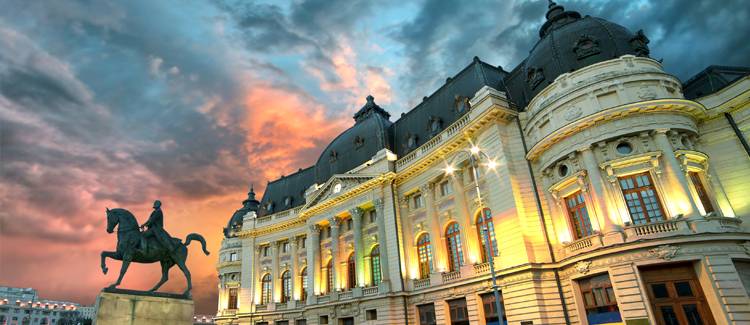
Bucharest, the capital of Romania, is the most important cultural and economic center of the country. Founded more than five centuries ago, this is the perfect starting point your Romania tour. In the ‘30s Bucharest was known as “Little Paris”, due to its large boulevards lined with trees and boasting a beautiful Belle Époque architecture. Nowadays you will probably be surprised by the eclectic mix of architectural styles, from the ruins of Vlad Tepes’s fifteen Century palace, all the way to present day glass buildings.
- The Palace of Parliament (Casa Poporului/People’s House). After the Pentagon, this is the second largest administrative building in the world. The massive construction started in 1984 - spanning over 365 000 m2, was built using over 20 000 workers and 700 architects. It is also the most expensive administrative building in the world, with an estimated cost of 3 billion Euros.
- Cismigiu Gardens. The oldest of Bucharest’s parks. Built in 1847 this was the place where aristocracy spent their free time. Today this is the perfect location for a morning jog, a tranquil boat ride or a relaxing evening stroll.
- Revolution Square is the most important public square in Bucharest and a landmark of local and national history. The square is home to some of the most popular architectural and cultural reference points, such as the Romanian Athenaeum (Philarmonic) and the former Royal Palace, which nowadays houses the National Art Museum. On the opposite side, in contrast with Romania’s royal past, we can find the former headquarters of the Communist Party, where the infamous communist leader, Ceausescu gave his final speech in December 1989.
- Old Town - Throughout history, the historical center of Bucharest was the main commercial area of Bucharest, as many foreign merchants came here to sell their produce. Currently, the area is a popular meeting spot, where tourists and locals, alike, can enjoy one of Europe’s most animated night life. Some of the major attractions in the Old Town, include: the historical complex Curtea Veche, the Stavropoleos Monastery, the Palace of Romania’s National Bank, the oldest surviving restaurant in Bucharest – Caru’ cu Bere and the elegant Macca-Villacrosse Passage, amongst many more interesting sites.
Bran Castle
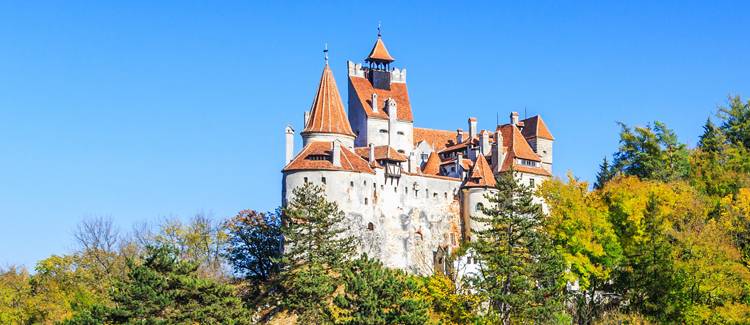
Located 30 km from Brasov, between Bucegi and Piatra Craiului mountains, Bran Castle is an important national monument and a landmark for Romanian tourism, due to its beauty and impressive setting. Moreover, the castle is known worldwide as being the source of inspiration for Dracula’s legend, whose spirit it is said that still haunts these ancient places. The castle was built between 1377 – 1382, on top of a rock which offers a spectacular bird’s eye view over the surrounding area and the Bran pass. The Bran Castle was nicknamed Dracula’s Castle by foreign tourists who came in search of Bram Stoker’s famous character, following in the footsteps of the novel. Nowadays, it houses the Bran Museum, which includes multiple exhibits of period furniture, weapons and armor, a small exhibit of medieval torture instruments, as well as a courtyard with traditional houses from this region.
Peles Castle

Located in the beautiful town of Sinaia, the Peles Castle reminds of the interwar period, being one of the most important architectural ensembles in Romania. The former summer residence of the first Romanian royal couple, King Carol I (1866 – 1914) and Queen Elizabeth, it was originally built as a leisure area for the Romanian monarchs and nobility. The construction has a unique character and an impressive artistic value, remaining one of the most important and beautiful monuments in Europe.
Danube Delta

Covering an area of 4 152 km2, The Danube Delta is the largest remaining wetland in Europe and the only delta in the world declared a biosphere reserve. This exotic region, boasting more than 1200 species of plants & trees and over 100 species of fish has one of the richest ornithological fauna on the continent, counting on approximately 325 species in total, amongst which unique colonies of pelicans, that symbolize resourcefulness and abundence. The youngest land of Romania was formed during the glacial period and evolved in close contact with the three arms of the Danube, which nourished the land: St. George, Chilia and Sulina. The incredible wealth of natural attractions of the Danube Delta determines more and more tourists to join the venture of exploring this wonderful land and discovering its well hidden secrets. The quiet atmosphere helps relax the mind and body and brings joy for those who love and respect nature.
Sibiu
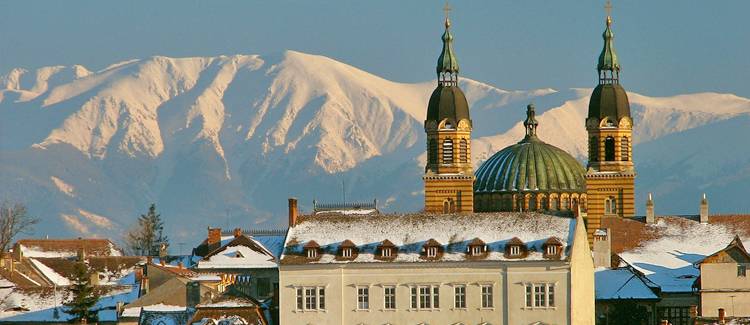
The past and present, blend harmoniously in Sibiu county. Traditional villages, historically rich towns, religious & ethnic diversity, the abundance of architectural styles and the authentic cultural life, make for one of the richest and most important regions of Romanian tourism.The impressive Carpathian mountain range, completes this picture perfect destination, which is just waiting for you to discover it.
Opened in 1817, the Brukenthal Museum in Sibiu is one of the first museums in Europe and its exhibitions include paintings by famous artists such as Rubens, Van Dyck and Teniers.
Museum of Traditional Folk Civilization in Sibiu is one of the world's largest outdoor museums. Located south of Sibiu, the museum contains works of traditional, pre-industrial, Romanian folk civilization. Houses, workshops and building complexes are scattered around a lake surrounded by forest.
Sighisoara
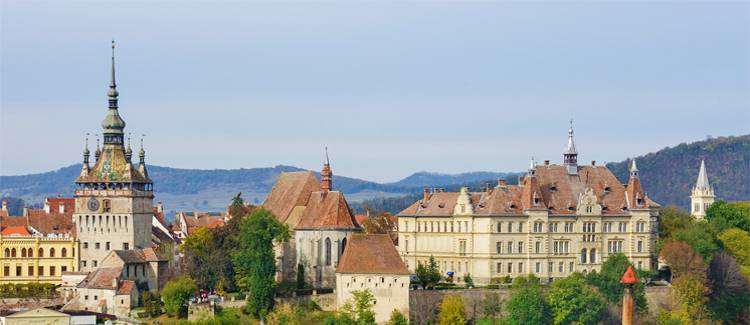
Built by the Saxons in the twelfth century, Sighisoara is the last medieval citadel in Europe, which was continuously inhabited from medieval times to present. For this amazing fact, it was included on the UNESCO world heritage list. In the past, each of the citadel’s towers were built, preserved and defended, in case of attacks by one of the city’s guilds. Out of the 14 original towers, 9 are still standing. The most important of the towers which became also the symbol of Sighisoara, is the magnificent Clock Tower – it boasts a height of 64 meters and can be seen from every point of the citadel. Its masterpiece - the clock - displays 7 figurines, carved out of linden wood, which represent the pagan roman gods: Diana, Mars, Mercury, Jupiter, Venus, Saturn and the Sun. Every God, depicts one of the seven days of the week. While in Romania, you should definitely let yourself be charmed by the original appearance of the citadel’s houses, some dating from the fifteenth century, by the narrow streets paved with river stones and by the cheerful atmosphere, all of which, give the citadel’s its unique look and feel.
Monasteries of Bucovina
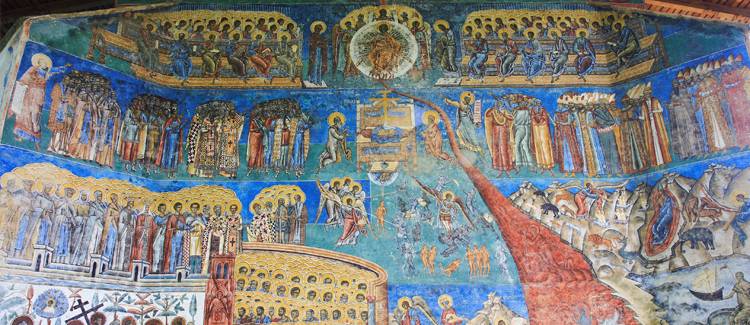
The north-eastern province of Romania, Bucovina, is much appreciated for its beautiful exterior frescoes, painted on the walls of its monasteries. These religious edifices reflect the development of civilization in Moldova during the XV and XVI centuries, under the reign of Stephen the Great. Bucovina became a tourist attraction due to its very well preserved old places of worship, painted with unique pigments of colors, whose composition are yet to be discovered. Bucovina is the ideal place to visit if you’re looking to harmoniously mix history, rich cultural heritage, excellent food and picturesque landscapes.
Transfagarasan Road
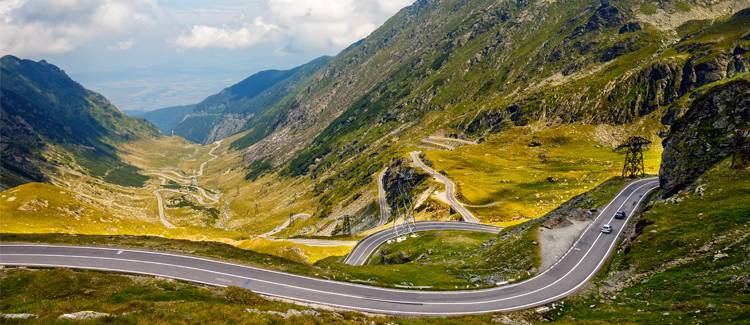
It was built in the ’70’s, with sweat and tears and a huge amount of lives lost, during its construction. Nonetheless, the Transfagarasan Road is an extraordinary engineering achievement. The British television show Top Gear named it “the best driving road in the world”. With spectacular altitude variations, steep mountain ridges, colorful flora, a tranquil glacial lake and a roaring waterfall, the Transfagarasan road captivates you at every turn. The wild landscape is breathtaking, especially on the strip where it reaches the maximum altitude of 2042 m. Because the road was built at a very high altitude, you can only drive on the Transfagarasan road, during the summer season.
Sapanta
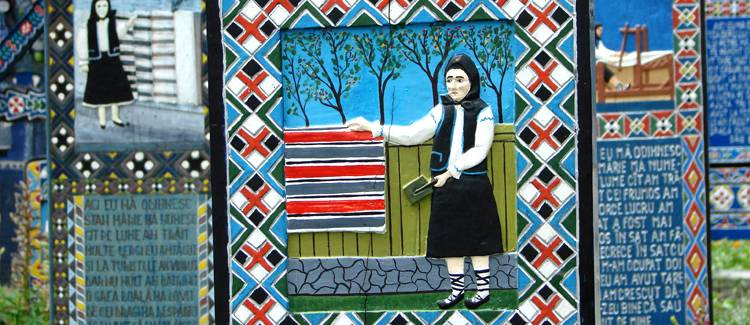
The Merry Cemetery in Sapanta is one of the most popular tourist attractions in Romania, offering its visitors a once in a lifetime experience. It is a site like you have never seen before. The entire cemetery – museum is a true monograph of the people from the magical land of Maramures, their memory being preserved in the most authentic way, together with their habits, occupations and traditions. The vivid colors that cover the tombs and crosses, together with the whimsical paintings and the funny epitaphs written on the graves, make for the most original and brave way in which one can confront the inevitable moment in everyone’s life: death. Legend has it that the cheerful attitude in the face of death is a custom derived from the Dacians, who believed in eternal life. They didn’t saw death as a tragic event but as a chance to meet the supreme god, Zamolxis.
Nearby you can find the highest wooden church in the world, the Sapanta-Peri Monastery. With a history that dates back to the twelfth century, it measures 78 meters, being taller than the New York Statue of Liberty (without pedestal).
Iasi
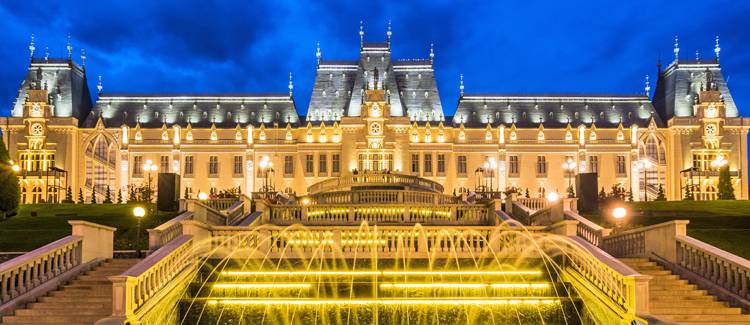
Iasi, known also as the capital of the Moldavia region, is one of the most beautiful cities in Romania. The city is known as an important cultural and economical hub and became famous for its academic institutions, including Alexandru Ioan Cuza University, the most prestigious one in Romania. Iasi is without a doubt, a fascinating city with a rich history and friendly people that will make you feel like home.
Mamaia
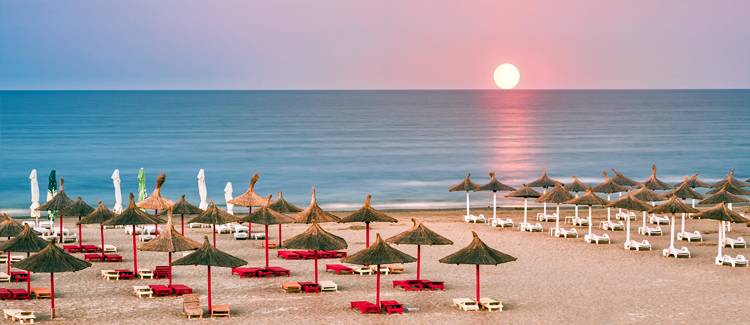
The town of Mamaia lies on a strip of land, between the Black Sea and Lake Siutghiol. In the 60’s and 70’s, became one of the favourite hangouts for middle class to rich Europeans, especially for Italians, due to its wide beaches, fine sand and lively entertainment. In recent years the seaside resort developed at a rapid pace, offering countless opportunities for recreation and leisure: water sports, amusement parks, the Aqua Magic complex, cinemas, bars, clubs and recovery centers. Mamaia is one of the most important tourist attractions on the Black Sea coast and it should not be missed, being more alive than never.
Brasov
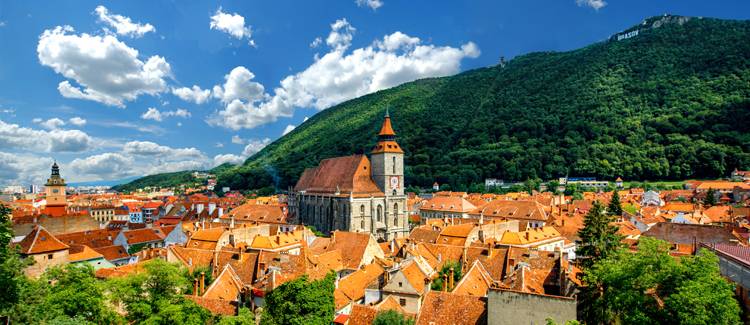
Due to its idoneous location, Brasov had a rapid economic growth and became an important trade center in Transylvania region. Bordered by the South Carpathian peaks and adorned with Gothic, Baroque and Renaissance architecture, as well as a wealth of historical monuments, Brasov is one of the most visited and loved cities in Romania.
Berca Mud Volcanoes
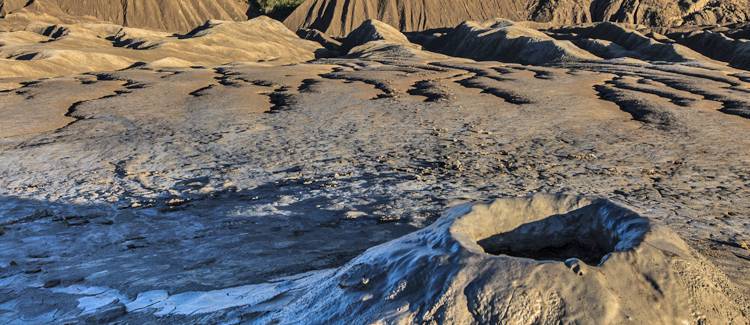
The Mud Volcanoes are actually a series of craters that can reach a height of 8 meters, which are continuously active due to the natural gas that comes in contact with the groundwater and the clay soil. The closer you get to the cones, the louder you can hear the bubbling of the gases coming out from the depths of Earth. This unique reservation stretches for over 30 hectares and represents a very rare natural phenomenon, which can be seen only in a few places on Earth. Tourists are impressed every time, by the strange looking, almost lunar landscape.
Targoviste
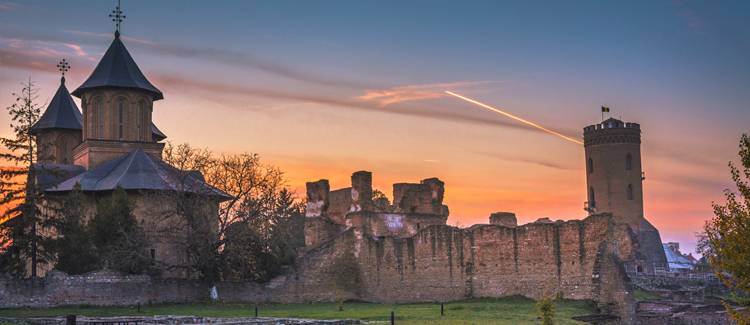
Chindia Tower is the symbol of Targoviste, impressing tourists with its unique architecture. Built in the fifteenth century, under the reign of Vlad the Impaler, it served as key element in defending the Royal Court.
Miclosoara
Miclosoara is considered one of the oldest and most beautiful places in Transylvania. The white houses with red roofs, green open plains and archaic atmosphere form an idyllic spot. The most important attraction here is the Kalnoky Castle, an old hunting lodge built in the 1500s. Renaissance, Baroque and Neoclassical architectural elements offer the castle an imposing and elegant appearance.
Natural wonders
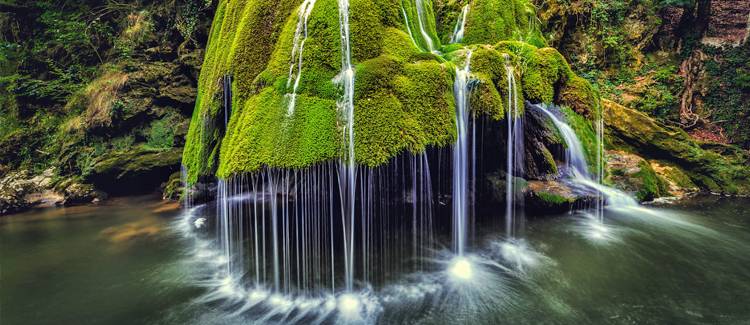
The forests in the Carpathian Mountains have the largest population of brown bears and wolves in Europe.
The Bigar waterfall, located on the spring with the same name, is one of the world's most spectacular water falls.
The Scarisoara Glacier in the Bihor Mountains is more than 3000 years old and the second largest underground glacier in Europe.
Inside the Turda Salt Mine you can visit the world’s largest salt mine museum. Although Turda Salt Mine was dug during the Middle Ages for extracting salt, it has become one of the most important tourist attractions in Romania.
Romania’s UNESCO Heritage
Romania has 8 UNESCO World Heritage Sites:
- The Churches of Moldavia
- The Dacian Fortress of the Orastie Mountains
- The Historic Centre of Sighisoara
- The Monastery of Horezu;
- The Villages with Fortified Churches in Transylvania
- The Wooden Churches of Maramures
- The Danube Delta
- The “Doina“ Song
